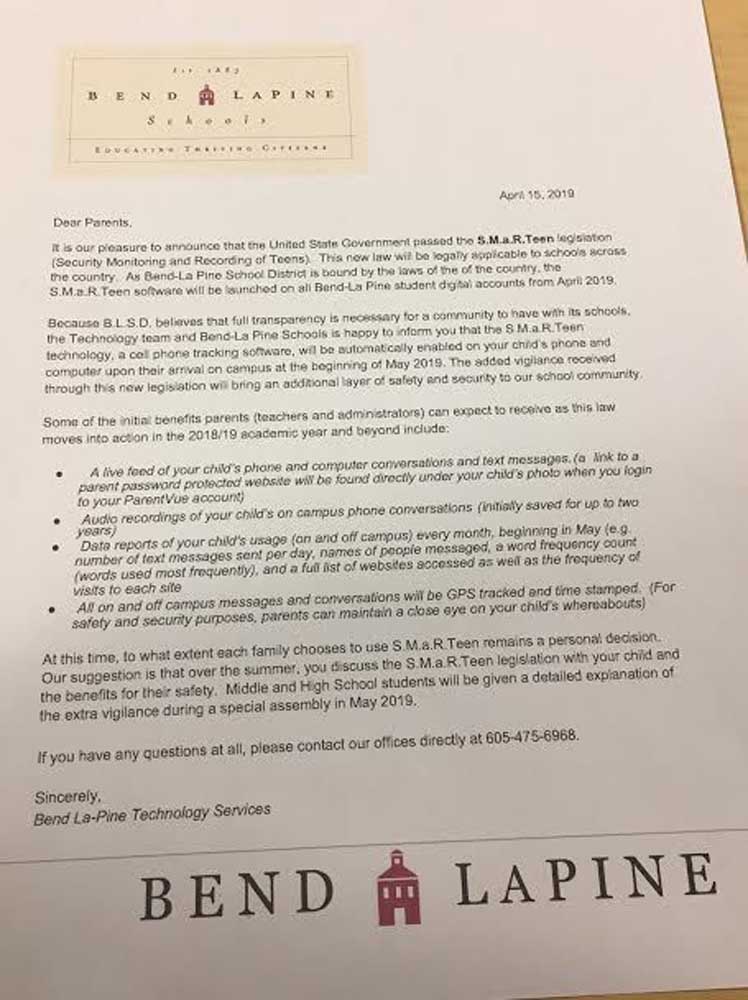Lukens column: In Bend, two creative teachers meet a humorless bureaucracy
Published 12:00 am Sunday, April 28, 2019

- This fake letter, part of a lesson on dystopia, was shared on social media. (Submitted photo)
Of all the things that can be said about bureaucracies, and there are many, one thing certainly cannot: that they possess a sense of humor. A pair of teachers at Bend’s Skyline High School might understand this better than anyone. Except, perhaps, the pair of students who got the teachers — and themselves — into trouble earlier this month.
The teachers, whom the district has refused to identify, prepared a language arts lesson on dystopias that has proved more valuable to their students, and to the rest of us, than they could have imagined. The lesson included a now-notorious fake letter, written by one of the teachers, that creates a Big Brotherish scenario in which the Bend-La Pine school district schemes to violate the privacy of students in outlandish ways.
Trending
The district, the letter explains, intends to launch software that will allow parents to access, among other things, “a live feed of your child’s phone and computer conversations and text messages.” The letter urges parents to make use of the snooping software, which supposedly was authorized by a federal law endowed with a memorable acronym, S.M.a.R. Teen (Security Monitoring and Recording of Teens). The letter includes a phone number for the use of curious parents.
The letter is clever, it speaks to the fears of students and it’s subtly funny. In other words, it’s exactly the sort of thing you’d hope teachers would produce at a school that promotes itself as “Rigorous. Relevant. Radical.”
And speaking of radical, the letter appears on school district letterhead. You can see where this is going.
The letter was distributed and collected during the language arts class period, according to district spokeswoman Julianne Repman. Nevertheless, she says, a student took a picture of the document and shared it on social media with language of the “Can you believe what the district is doing?” variety. Naturally, it went viral. District administrators were not amused.
The incident appeared on the radar screens of district administrators a couple of days later, says Repman, when the IT department raised the alarm, other schools began to call and parents started to ask questions.
Administrators informed schools that the letter wasn’t genuine. And then, believe it or not, they called the police, precipitating a brief investigation by the school resource officer. But an hour or so after the police became involved, says Repman, one of the Skyline teachers responsible for the letter came into her office and explained what had happened. Case closed.
Trending
At this point, the district’s bureaucracy really hit its humorless stride, and the results are truly depressing.
You can be sure the two teachers involved figured out instantly where they’d gone wrong. The letter should have said “this is fake” because some people were bound to take it seriously in the event that it escaped the classroom. Never mind that the phone number on the letter was a dead end.
But the district, instead of treating these teachers as sensible adults, decided to subject them to “coaching,” according to Repman, about ways to improve instruction, plan ahead in case lessons go awry and so on. None of this is remotely necessary at this point, of course, but it does send a message: Create waves, and you will be bored senseless and your time wasted by people determined to get your mind right.
The district, in true dystopian bureaucratic fashion, has declined not only to release the names of the teachers but also to explain why it refuses to do so. I didn’t ask for the teachers’ names because I want to criticize them, but, rather because somebody ought to give them credit publicly for doing great work here. District administrators sure aren’t. If the S.M.a.R. Teen letter is representative of the effort, creativity and good humor they put into their jobs regularly, then their students are very lucky to have them.
Consider, too, the district’s response to the teens who spread the letter on social media. The kids should have known that posting the letter would cause problems for their teachers. Not nice.
But what district policy or policies, exactly, did they violate? Repman said she couldn’t “get into the details of what the specific policy infraction” was. Very helpful, but not unexpected given the district’s long history of determined and arbitrary opacity.
Nonetheless, the students were punished: They had to apologize to law enforcement and complete some community service hours, according to Repman. Their use of technology has been restricted as well.
All of this for photographing a piece of their curriculum and sharing it on social media in a mischievously misleading way? Someone, call the cops! Oh, wait …
I hope it isn’t lost on the two kids that they’ve received community service for a prank that was a kind of community service itself. This month, hundreds, and possibly thousands, of district students and parents received a lesson about the value of skepticism. That’s a useful quality with which to counter scammers.
Speaking of lessons, the biggest one surely will not have escaped the teachers at the center of this incident. Their letter may have been fake, but its dark view of district overreaching wasn’t entirely off base.
— Erik Lukens is editor of The Bulletin.








